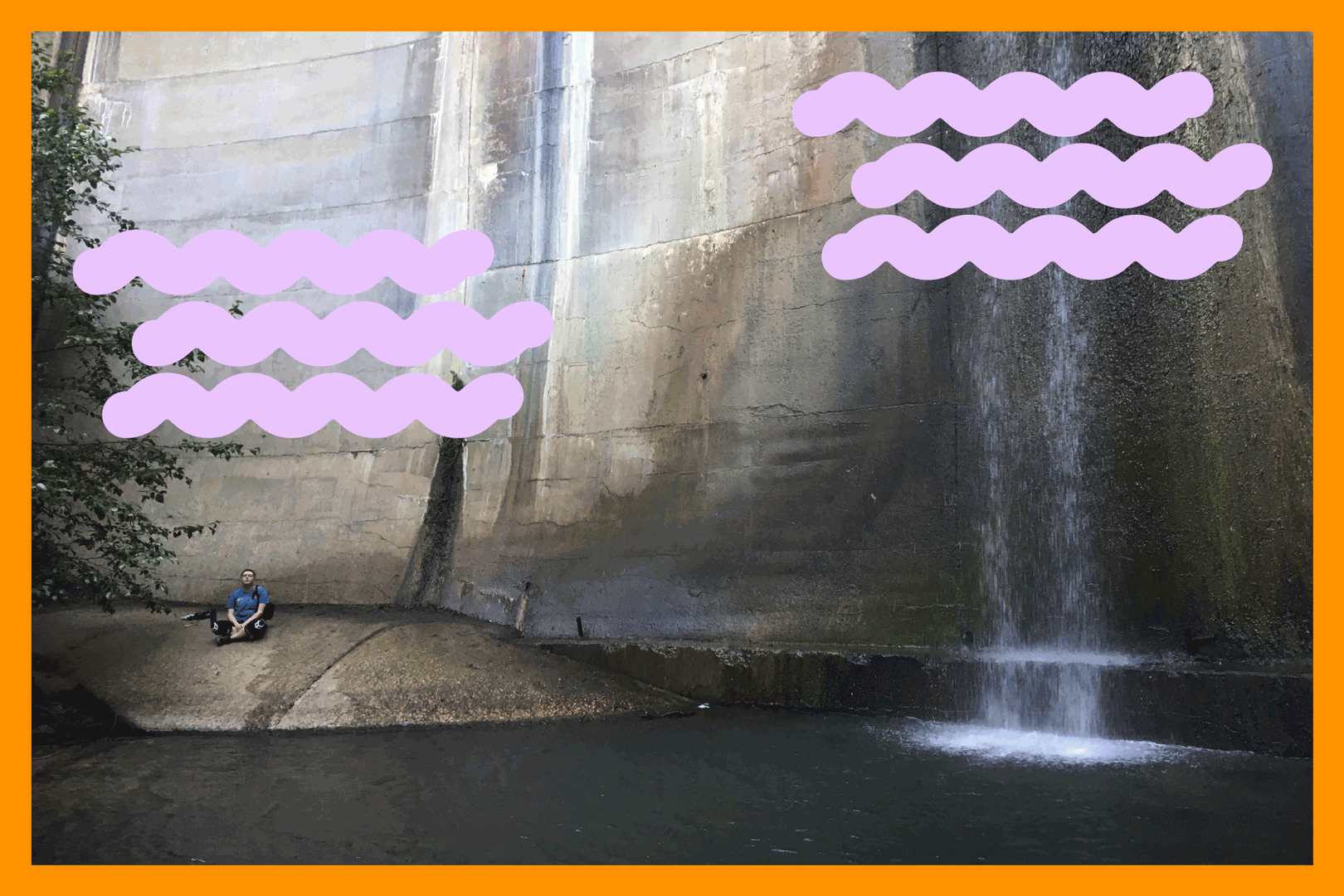Editor’s note: This newsletter is intended to feature a variety of inspiring voices from the Southern California outdoor scene. Starting this month, that voice will belong to Times staff writer Jaclyn Cosgrove, who will be writing The Wild from now on. Jaclyn enjoys hiking in Angeles National Forest and mountain biking on the least scary trails she can find.
Some trails offer the same comforting feeling as spending time with good friends and eating your favorite home-cooked meals.
That’s how I feel when hiking part of the Gabrielino National Recreation Trail near Pasadena. I often stray from the main trail to see the waterfall at Brown Mountain Dam, a roughly seven-mile round trip hike.
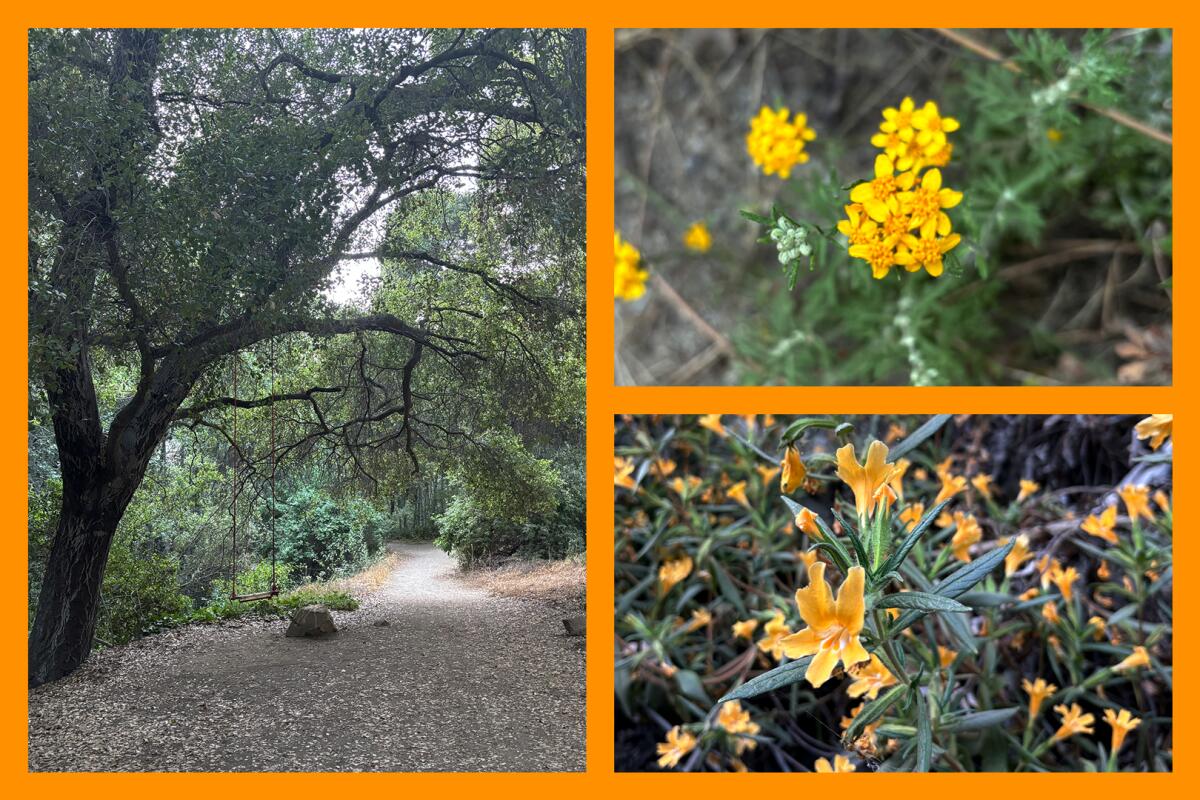
Left: Several coast oaks grow along the Gabrielino Trail, including this tree with a swing. Sit under these majestic trees and let them tell you a story. Top right: Several native plants and wildflowers grow along the Gabrielino Trail, including golden yarrow. Bottom right: Bush monkey flower (also known as sticky monkey flower) is a native shrub found along the Gabrielino Trail.
(Jacqueline Cosgrove/Los Angeles Times)
On bad, weird, or just boring days, I can often be found somewhere along the trail admiring the native plants: the laurel sumac with its taco-shaped leaves, the giant coast live oaks that provide lots of shade, the California buckwheat, sticky monkey flower, and golden yarrow. Sometimes I just sit near the Arroyo Seco, a 22-mile natural river, and listen to the sound of the river.
Newsletter
You’re reading The Wild newsletter
Sign up to receive expert tips on the best spots to explore Southern California’s beaches, trails, parks, deserts, forests and mountains in your inbox every Thursday.
Please enter your e-mail address
sign up
You may occasionally receive promotional content from the Los Angeles Times.
My dog, Maggie Mae, and I first hit this trail around 2019. After dozens of visits, Maggie now knows the route as well as I do, and she knows to head to the first water station shortly after crossing the second bridge over the bubbling Arroyo Seco.
This trail is suitable for people of all ages and fitness levels. Over the past five years, I’ve taken several friends and family, including some visiting from my home state of Oklahoma, on this trail, and now I’d like to share it with you.
First, logistics.
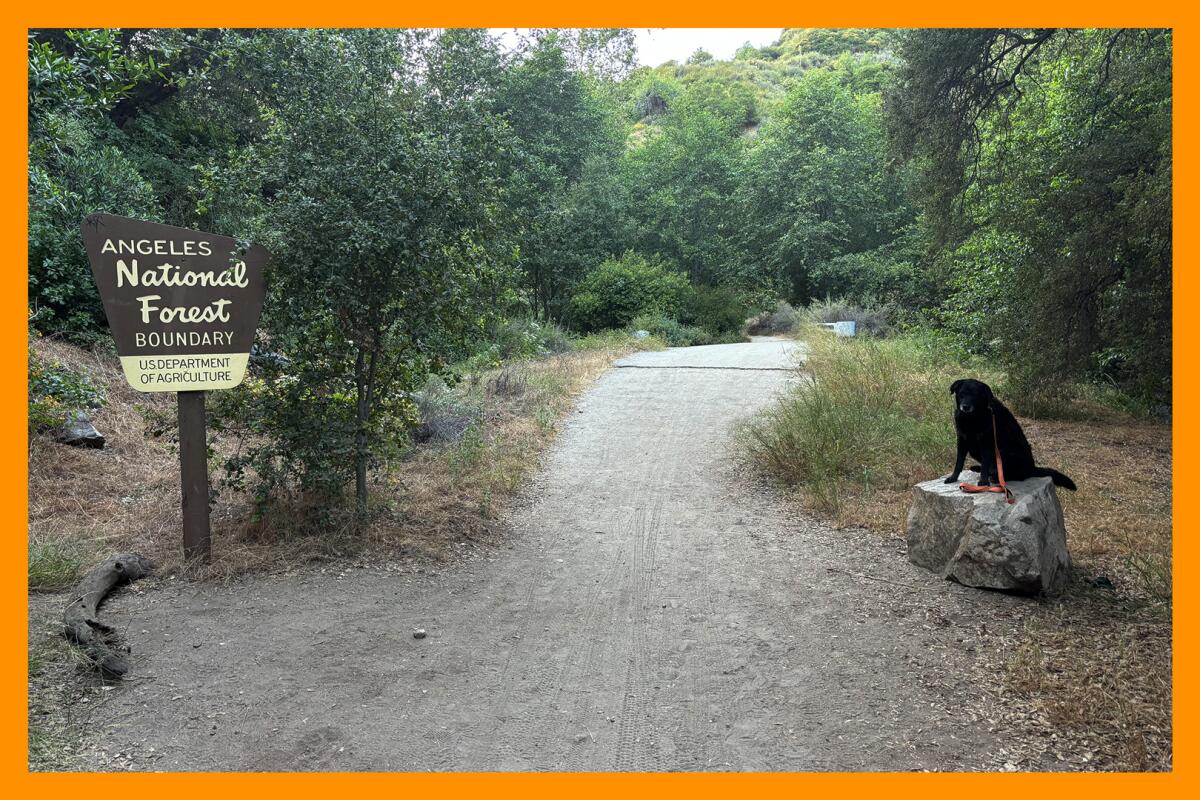
Maggie Mae, the author’s dog and hiking companion, poses on a rock at the boundary where the trail enters Angeles National Forest.
(Jacqueline Cosgrove/Los Angeles Times)
The trail begins outside of Angeles National Forest, so there is no parking fee.
Some people park in a small parking lot off the intersection of North Windsor Avenue and Ventura Street in Altadena. There is a gate that closes off vehicle traffic near this lot. For bicyclists and hikers in wheelchairs, this is a convenient place to enter the trail. The trail is paved and then becomes dirt. (Note: entering here extends the hike by about 1.4 miles round trip.)
I usually leave this parking area for the aforementioned trail users and instead head north on Explorer Road and park in the large dirt parking lot near the back entrance of NASA’s Jet Propulsion Laboratory.
From that parking lot, you can access the trail by climbing a short, steep paved path. I often joke with my friends that this section will be the most difficult part of the entire trail, since most of the route is a gradual uphill climb.
From here you can walk as far and as long as you like – you don’t have to go all the way to the dam falls to enjoy it.
The trail winds northwest, running alongside the Arroyo Seco, which you’ll cross several times. Along the way, you’ll probably see a few Western fence lizards, as well as red-tailed hawks, California towhees, and if you’re lucky, a great horned owl. A few months ago, one hiker said he saw a bear in the evening. If you head out near sunset, the sounds of frogs and toads croaking will make your heart sing.
In terms of effort, if you walk the trail all the way to the dam, your overall elevation gain will be less than 700 feet.
A few things to remember:
Plan ahead, as you’ll get wet feet if you don’t turn back at the first water crossing. Don’t build your own dam, as this will hinder efforts to restock the river with rainbow trout. If a friend built a dam, remove it before you leave. Gould Mesa Campground has new restrooms about 2 miles away. If you can’t wait until then, walk at least 70 steps from the river, especially in the second situation. Bring hiking poles to help with crossings and a travel towel. Starting in late summer, the Arroyo Seco may begin to dry up. Go see the river flow while you can. 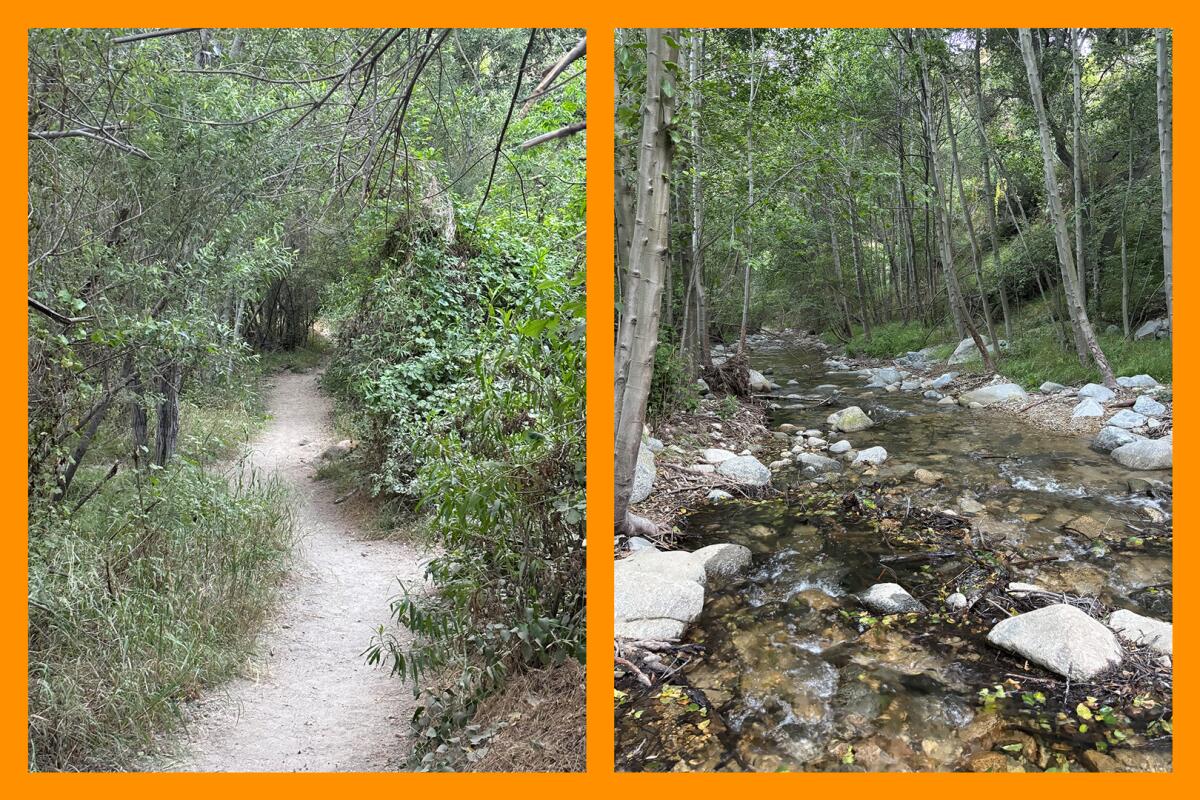
From left: This section of the Gabrielino Trail, also known as the Brown Mountain Dam Trail, has plenty of shade along the way to the dam. On the right is the Arroyo Seco, which the Gabrielino Trail runs alongside.
(Jacqueline Cosgrove/Los Angeles Times)
As you walk through this beautiful place, think of all those who came before you. The original inhabitants of this area, the Tongva Hahamogna people, lived along the Arroyo Seco and had several villages near the water before Spanish settlers arrived in the 1700s and 1800s. Historians say they lived in what is now Highland Park, South Pasadena and around Pasadena, and they probably lived on land where you park and hike along this trail.
According to the Altadena Historical Society, in the 1920s, more than 200 cabins were built along the Arroyo Seco River, from its mouth near the parking lot to a place called Switzer’s Camp. The cabins were part of the U.S. Forest Service’s Forest Summer House Initiative, and one of the most popular areas was along the Arroyo Seco River.
However, according to the Historical Society, those plans were ended for a number of reasons, primarily the construction of Brown Mountain Dam, which necessitated the removal of the cabin.
Brown Mountain Dam itself has been a source of controversy, and river advocates like Tim Brick, executive director of the Arroyo Seco Stewardship Association, would like to see it removed in the near future.
Brick said Brown Mountain Dam, despite its beautiful waterfalls, is one of several land features along the river that are preventing rainbow trout from repopulating the river.
“The Arroyo Seco is an important tributary to the Los Angeles River, and if rainbow trout or rainbow trout are returning to the Los Angeles River, it’s going to come from the Arroyo Seco, so we consider the Arroyo Seco a very important part of the Los Angeles River,” Brick said.
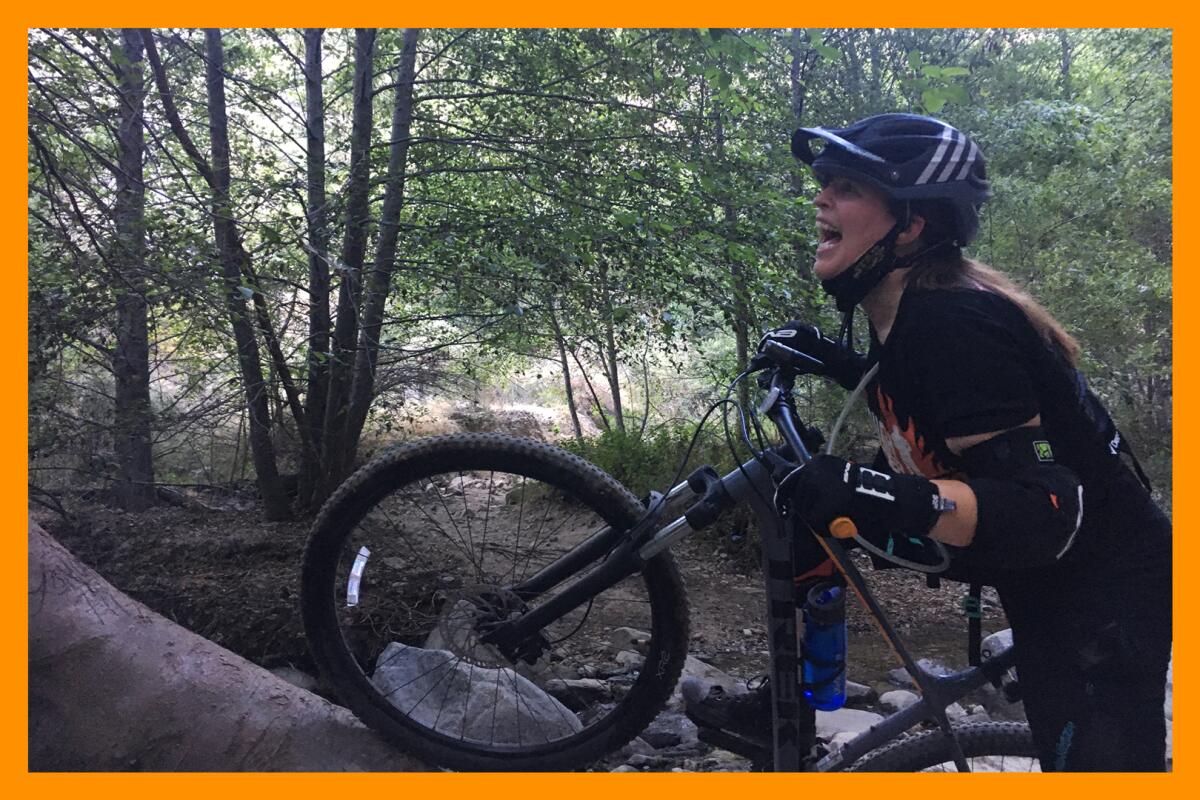
The author mountain bikes during a trip along the Gabrielino Trail.
(Jacqueline Cosgrove/Los Angeles Times)
I enjoy hiking not only with the right equipment, but also with the conditions where I am, and on this 7.2 mile hike I did both, and I encourage you to do the same!
Times editorial library editor Carrie Schneider contributed to this report.

Three things to do
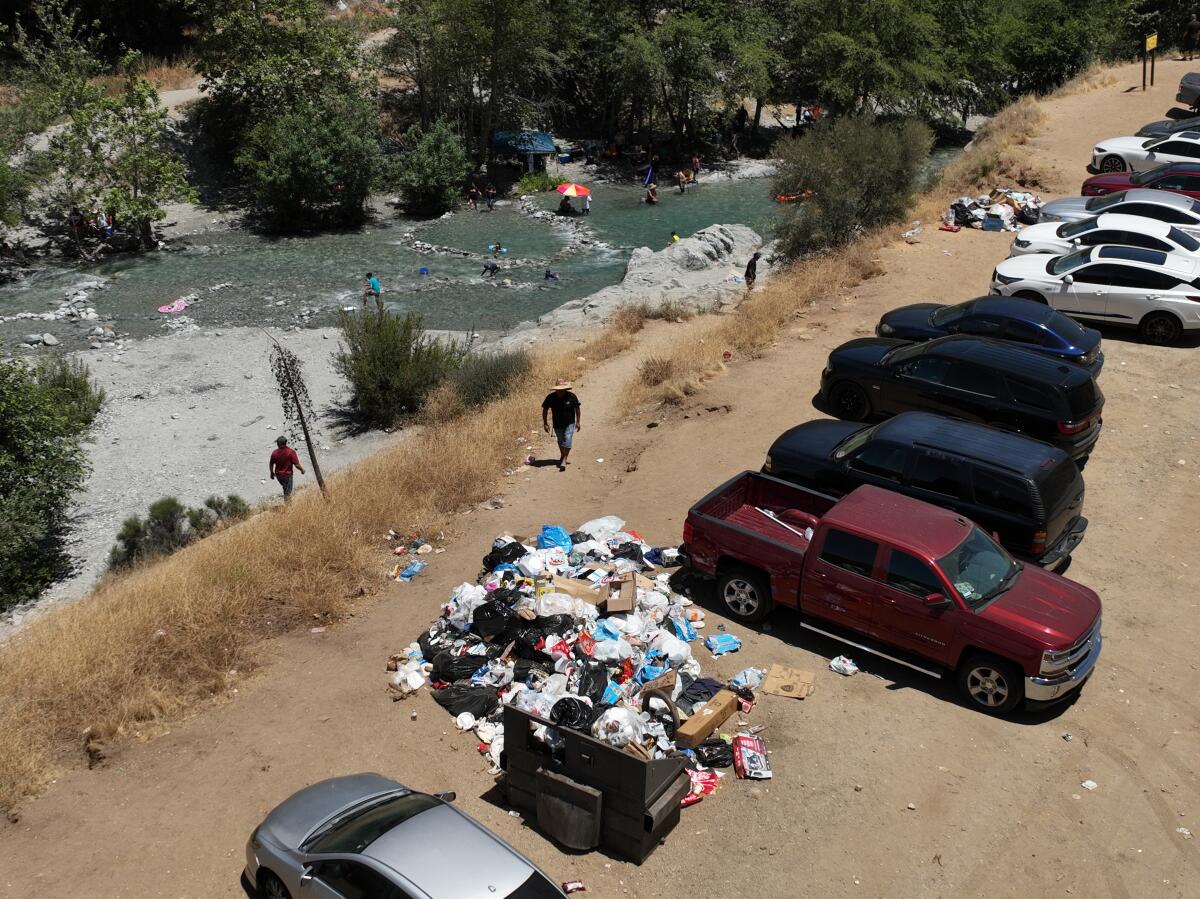
Last July, trash piled up along a roadside in the East Branch of the San Gabriel River in San Gabriel Mountains National Monument in what volunteers cleaning up the area have dubbed the “East Branch Toilet.”
(Allen J. Schaven/Los Angeles Times)
1. Help clean up the San Gabriel River near Azusa
On busy summer weekends, as many as 10,000 people can visit the East Fork of the San Gabriel River. Unfortunately, they often leave mountains of trash behind. East Fork Golden Preservation will host a cleanup of the area from 7 to 10 a.m. Sunday. Groups will meet at Oaks Picnic Area on East Fork Road in Azusa. Golden Preservation, which has collected more than 8,505 pounds of trash on the East Fork, will provide gloves, bags and trash grabbers. The organization encourages people to bring water and wear clothes they don’t mind getting wet or dirty. To register, send a direct message to @eastforksgoldenpreservation on Instagram. Snacks and lunch will be provided to guests who preregister.
2. See a free movie or concert at an LA County park
This summer, Los Angeles County will host its popular Parks After Dark program at 34 parks. Friends and family are encouraged to check out the free summer concerts, movie nights and other free programming. You can dress up as Ken at one of the 2023 “Barbie” movie screenings, enjoy some jazz or rock out to a Beatles tribute band. You can see the full entertainment list here. Bonus: This year’s program also includes several public pools that will be open from late Thursday night through Saturday.
3. Learn about California surf culture in Malibu
Hawaii’s Duke Kahanamoku is said to have introduced surfing to Malibu’s early surfers in the mid-1920s. Nearly 100 years later, the Malibu Arts Commission celebrates that rich history with a community art exhibit called “Tales of a Seaside Town.” The exhibit features several local artists. A free opening reception will be held Sunday at noon at Malibu City Hall, where guests can enjoy light refreshments and live music. No prior reservations are required. The exhibit will be on display from July 15 to August 23 at the Malibu City Gallery in City Hall, 23825 Stuart Ranch Road. The gallery is open weekdays from 8 a.m. to 4 p.m. Admission is free. For more information, visit malibuartsandculture.org.

Must Read
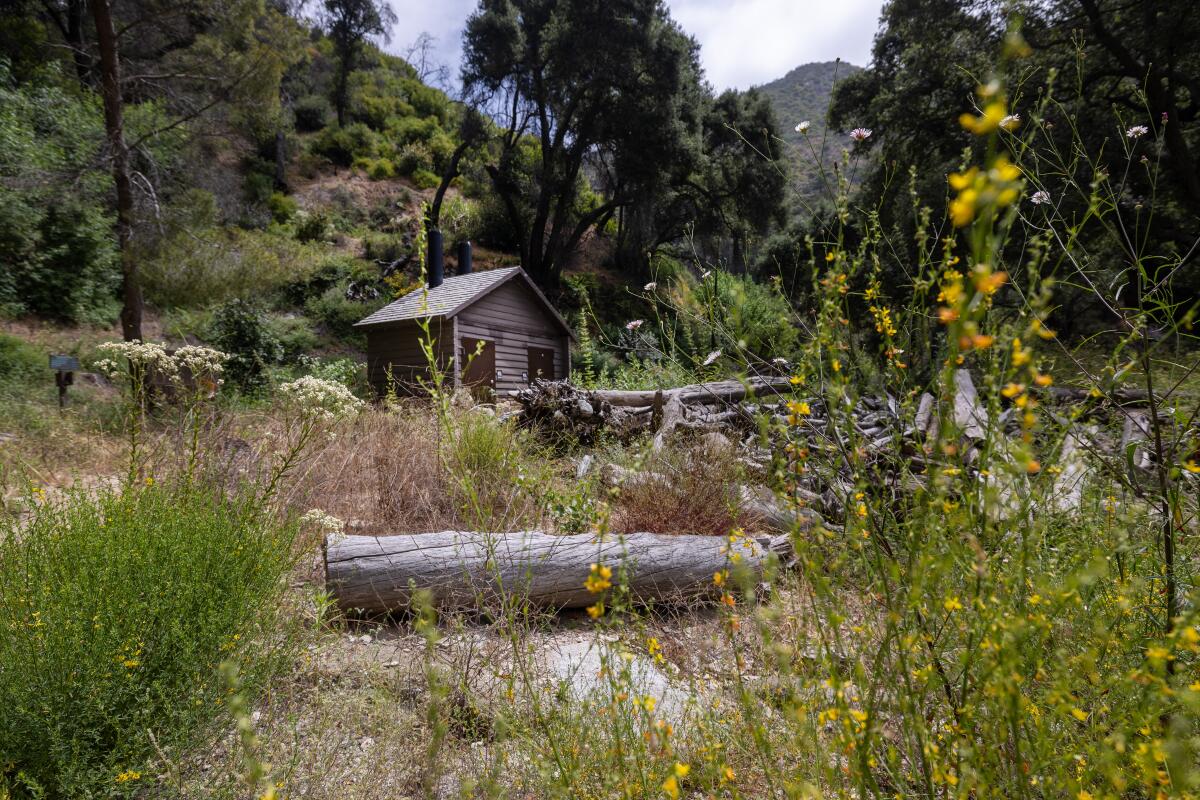
The toilets at Roberts Camp in Big Santa Anita Canyon are no longer in use after flooding and mudslides washed away the road that serviced the toilets.
(Brian van der Burg/Los Angeles Times)
Good news: One of the most beautiful parts of the Angeles National Forest, severely damaged by the 2020 Bobcat Fire, may finally be reopening. Bad news: There are far fewer available restrooms in the Big Santa Anita Canyon area, raising concerns among cabin owners that visitors will relieve themselves in the wrong place while visiting. My colleague Lila Seidman has the scoop (sorry!) about the “defecation phobia” of people like cabin owner Justin McInteer. McInteer said that before the fire closed the area, “I would just go and pick up the excrement.” No one is going to take up that hobby. Will educating visitors on the “Leave No Trace” principle be enough?
Have a nice adventure.

P.S.
About a month ago, a Reddit user asked me to investigate whether the Angeles National Forest was planning to sell the trailhead parking lots to private companies and charge access fees. The concern arose after Wrightwood-based resort Mountain High unveiled its new Big Pines Parking Pass, which the company said “replaces the Forest Service Adventure Pass at all our day-use sites and trailheads (Vincent Gap and Inspiration Point).” (You can see a full list of Big Pines Parking Pass coverage here.) I spoke with Matthew Bocacci, a district ranger for the San Gabriel Mountains National Monument, who told me that forest officials believe a private permittee would be better able to manage the Grassy Hollow Visitor Center and nearby sites, which have been difficult to staff due to their distance from Los Angeles. Bocacci said the Angeles National Forest has no plans to contract with private companies for other parking lots or facilities in the forest. This appears to be a one-time occurrence, but in fairness, Mountain High has added some fun recreational opportunities since winning the contract, including kayaking on Jackson Lake. Let’s hope that the contract means the area remains pristine and well-maintained. Want to learn more? Read my post on Reddit.
Plus, if you want to help us discover even more great spots, you can share your favorite hikes with my colleague, Deborah Vankin. Deborah and I, along with a few others, just finished updating our hiking guide to highlight 70 of the best hikes in the LA area. Have we missed any? Let us know!
For more inside information on Southern California’s beaches, trails and parks, check out past issues of The Wild. Click here to view this newsletter in your browser.

